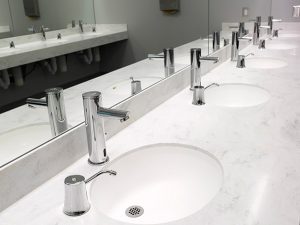
Advancements help commercial bathrooms go greener
October 22, 2017 | By David Scelsi

Commercial facility managers are now actively looking for ways to curb water use and cut costs without sacrificing performance, quality and style.
Economic challenges. Droughts. Green initiatives. Laws and standards. It is hard to pinpoint one single reason water has risen to the forefront of the sustainability conversation in the past few years. But one thing is certain, as demand for greener facilities revs up, advances in plumbing technology and design are changing the way commercial bathrooms look and function.
Commercial bathrooms have long been a haven for water waste and are, in fact, one of the top consumers of water in commercial facilities, according to the U.S. Environmental Protection Agency. Restrooms account for 45 per cent of water use in educational facilities, 37 per cent in office buildings, and 35 per cent in hospitals. In fact, there’s almost no facility where bathrooms are not responsible for at least 30 per cent of the facility’s total water use.
Often faced with high traffic and heavy use, restrooms were once designed with an eye more toward durability than efficiency, but commercial facility managers are now actively looking for ways to curb water use and cut costs without sacrificing performance, quality and style.
Canada is among the top 10 water-consuming countries in the world and, like many others, is facing rising pressures, and incentives, to reduce water use.
Programs such as LEED, for example, encourage the development of environmentally friendly facilities, and its prevalence is growing in Canada. More than 34 million gross square meters (gsm) across more than 2,500 projects were LEED certified in Canada in 2016, up from 26 million gsm the prior year, according to the U.S. Green Building Council, which operates the sustainability certification program.
CUTTING WATER USE
The standard water-consuming fixtures in bathrooms – faucets, toilets and urinals – have all seen technological advances in the last several years that allow them to function well without guzzling gallons of water with every twist of the handle.
Water use can be cut at sinks in a couple of ways. The low-hanging fruit of water conservation at the sink is aerators. These inexpensive, easy-to-install devices can reduce water flow to as little as 1.3 liters per minute (lpm), a dramatic reduction from the 8.3 lpm often seen on standard faucets. Vandal-resistant versions also prevent unauthorized removal.
Additionally, upgrading traditional manual faucets to hands-free sensor faucets can save as much as 3.78 liters per handwash over manual faucets by flowing water only when hands are under the faucet. Sensor faucets also avoid the potential for someone purposefully or accidentally leaving water running when they walk out. An automatic shut-off feature ensures any malicious efforts to cover or otherwise interfere with the operation of the sensor still do not result in an untended, endless flow of water.
On the other side of the restroom, urinal flush valves are commonly down to 0.47 liters per flush, and waterless versions are also available, though they require ongoing maintenance to replace cartridges. High-efficiency toilets use as little as 3.8 liters per flush, and retrofitting kits mean older flushometer toilets can be updated to use much less water.
Advances in plumbing are also making it more feasible for facilities to reclaim and recycle non-potable water to flush toilets.
SURVEYING THE SCENE
Before undertaking any changes, a commercial facility should understand exactly where its water is being used, so any well considered approach to bathroom design would include a water audit.
An effective audit will analyze water flow across the facility and determine where efficiencies can be gained with repairs, retrofits or updated equipment. Often times these updates can have a return on investment measurable in days, rather than years.
More and more designers and engineers are using water audits to identify areas where increased efficiency can garner the most economical and environmental bang for the buck.
BEYOND WATER
Beyond just saving water, other design advances help commercial restrooms operate efficiently while supporting good health and hygiene.
Hydrogenerators, for instance, which harness the flow of water to produce energy, can be used to power sensor faucets and flush valves, eliminating the need for regular battery replacements or electrical wiring.
Sensor faucets and flush valves also contribute to a cleaner restroom by eliminating the most common touchpoints in restrooms, places where germs or other contaminants can accumulate and be passed from user to user.
A study recently published by the Society for Risk Analysis revealed that installing touchless fixtures can significantly reduce the transmission of norovirus, a common cause of illness (http://sra.org/sites/default/files/pdf/press-release/SRA%20Norovirus%20release.pdf).
Sanitation concerns are also evident in trends and designs that address overall hygiene, including integrating sinks into countertops to eliminate the seam between two materials where dirt and bacteria can collect. Designers are also moving to select quartz and solid surface materials, which feature non-porous surfaces that are low-maintenance and minimize bacteria growth.
Regardless of facility type, there are solutions in modern design to tackle nearly any challenge or need for commercial restrooms, and these accelerating technological and design advances are making these places havens for sustainability and efficiency.
David Scelsi is marketing product manager with T&S Brass.
Investing for the long haul
Commercial facilities often see an astounding volume of traffic in restrooms. Hospitals, schools, airports, stadiums and more will typically cater to thousands on a given day. Keeping bathroom fixtures functioning smoothly day in and day out is critical.
Investing in durable, reliable products designed especially for commercial applications ensures facilities get the best performance and longest life.
With regular maintenance for wearable parts, a quality faucet or flush valve can withstand years of heavy use. An inexpensive alternative may seem appealing at the outset but will require more frequent repair and replacement.




